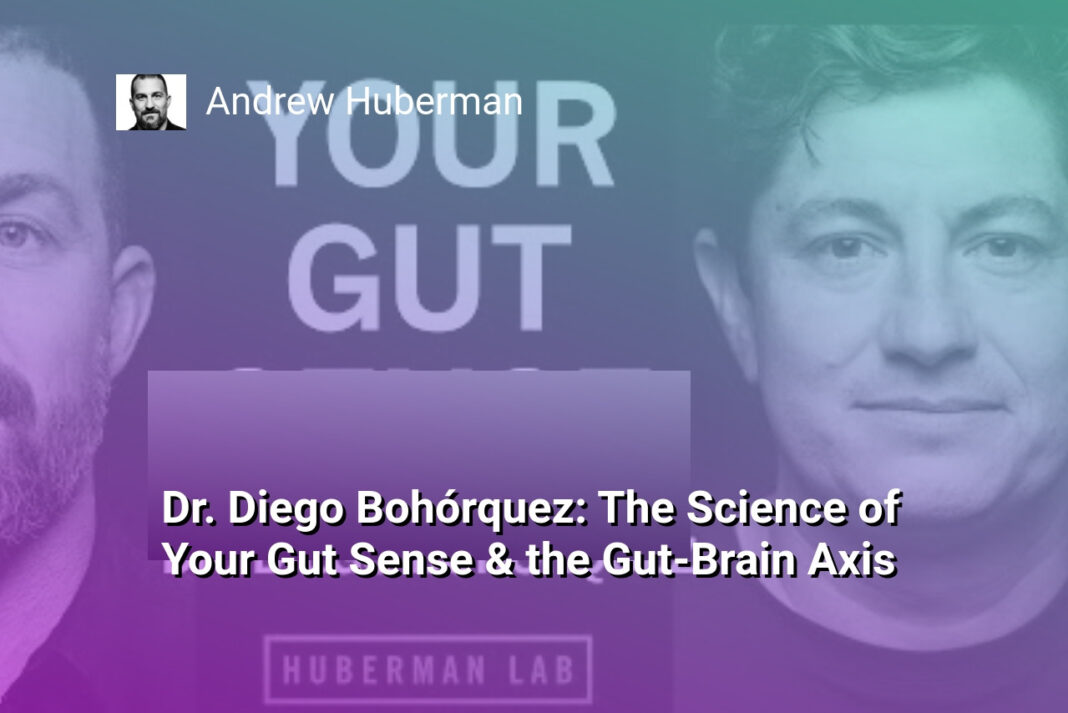The Bottom Line:
- The gut-brain axis refers to the direct communication between the gut and the brain, beyond just hormonal signaling.
- The gut contains specialized sensory cells that can detect various components of food, including amino acids, fats, sugars, temperature, and acidity, and then communicate this information to the brain.
- This gut sensing ability influences our emotions, cravings, and overall well-being, rather than just our digestion.
- Dr. Borquez’s unique expertise in both gastrointestinal physiology and neuroscience allows him to provide insights into how specific foods and food combinations impact our feelings and behaviors.
- Dr. Borquez’s personal background, growing up in the Amazon jungle, has also influenced his scientific approach and understanding of the gut-brain connection.
Understanding the Gut-Brain Axis
The Gut’s Sensory Capabilities
The gut is far more than just a digestive organ – it is a complex sensory system that continuously communicates with the brain. Within the gut, there are specialized sensory cells that can detect various components of the food we consume, including amino acids, fats, sugars, and even the temperature and acidity of the contents. These sensory cells are connected to the nervous system and transmit this information directly to the brain, bypassing the traditional hormonal pathways.
The Gut-Brain Dialogue
This direct communication between the gut and the brain is what forms the gut-brain axis. The brain is constantly receiving and interpreting the sensory information from the gut, which in turn influences our thoughts, emotions, and behaviors. For example, the gut’s detection of certain nutrients can trigger the release of neurotransmitters like serotonin, which can impact our mood and feelings of well-being. Conversely, our emotional state and stress levels can also influence the gut’s functioning, creating a bidirectional relationship between the two systems.
The Gut’s Impact on Overall Health
The gut’s sensory capabilities and its direct communication with the brain have far-reaching implications for our overall health and well-being. The gut’s ability to detect and respond to the various components of our diet can influence our food preferences, cravings, and even our propensity for certain health conditions. By understanding the gut-brain axis, we can gain insights into how our dietary choices and gut health can impact our cognitive function, emotional state, and even our risk of developing conditions like depression, anxiety, and certain neurological disorders.
The Sensory Cells of the Gut
Unveiling the Sensory Cells of the Gut
The gut is home to a remarkable network of sensory cells that play a crucial role in our overall well-being. These specialized cells, known as enteroendocrine cells, are scattered throughout the lining of the gastrointestinal tract, from the esophagus to the rectum. Unlike the taste receptors on our tongue, which detect the five basic tastes, these gut sensory cells are capable of detecting a much wider range of stimuli, including the presence of specific nutrients, the temperature and pH of the gut contents, and even the mechanical stretching of the gut wall.
Nutrient Sensing: The Gut’s Taste Buds
The enteroendocrine cells in the gut are equipped with a diverse array of receptors that allow them to sense the presence of various nutrients, such as amino acids, fatty acids, and carbohydrates. These receptors act as the gut’s “taste buds,” providing the brain with detailed information about the composition of the food we consume. This nutrient sensing ability is crucial for the gut’s role in regulating appetite, digestion, and nutrient absorption.
Gut-Brain Communication: A Two-Way Street
The sensory information gathered by the enteroendocrine cells is not simply a one-way street. These cells communicate with the brain through a complex network of neural pathways, including the vagus nerve, which serves as a direct line of communication between the gut and the brain. This bidirectional communication allows the gut to influence the brain’s perception of hunger, satiety, and even mood, while the brain can also modulate the gut’s functions, such as motility and secretion.
By understanding the intricate workings of the gut’s sensory cells and their communication with the brain, researchers are gaining valuable insights into the gut-brain axis, which holds the key to unlocking new strategies for improving overall health, from managing appetite and weight to addressing mental health conditions.
Gut Sensing and Communication with the Brain
The Gut’s Sensory Capabilities and Brain Communication
The gut is far more than just a digestive organ – it is equipped with a sophisticated sensory system that constantly monitors the contents and conditions within it. This sensory information is then rapidly communicated to the brain, allowing for a dynamic and responsive gut-brain axis.
Sensing Nutrients and Micronutrients
The gut contains specialized sensory cells that can detect specific components of the food we consume, including amino acids, fats, sugars, and various micronutrients. These cells act as the gut’s “taste buds,” providing the brain with detailed information about the composition and qualities of the ingested food. This allows the gut to relay critical data about the nutritional profile of our diet, which the brain can then use to drive appropriate physiological, emotional, and behavioral responses.
Sensing Temperature, Acidity, and Other Gut Conditions
In addition to sensing the chemical makeup of the gut contents, the gut’s sensory system can also detect other important parameters, such as temperature, acidity, and the presence of certain molecules. This allows the gut to provide the brain with a comprehensive picture of the overall state and environment within the digestive tract. The brain can then use this information to coordinate appropriate responses, such as adjusting digestive processes, altering food preferences, or modulating mood and energy levels.
The gut-brain axis is a bidirectional communication pathway, with the brain also sending signals back to the gut. This dynamic interplay allows the two systems to work in harmony, ensuring that our physiological, emotional, and behavioral responses are closely aligned with the current state of our digestive system. By understanding and harnessing this gut-brain connection, we can gain valuable insights into how our dietary choices and gut health can profoundly impact our overall well-being.
The Impact of Food on Gut Sensing and Behavior
Decoding the Gut’s Sensory Capabilities
The gut is far more than just a digestive organ – it is a complex sensory system that constantly communicates with the brain. Within the gut, there are specialized cells called enteroendocrine cells that act as sensors, detecting various components of the food we consume. These cells are able to sense the presence of amino acids, fatty acids, sugars, and even the temperature and acidity of the gut contents.
The Gut’s Influence on Behavior and Emotion
The information gathered by these gut sensors is then rapidly transmitted to the brain via the vagus nerve, a direct neural connection between the gut and the brain. This allows the gut to influence our thoughts, emotions, and behaviors in real-time. For example, the detection of certain nutrients can trigger the release of hormones that promote feelings of satiety, while the presence of irritants or toxins can elicit feelings of nausea or discomfort.
The Gut-Brain Feedback Loop
The relationship between the gut and the brain is not a one-way street, however. The brain also sends signals back to the gut, creating a dynamic feedback loop. This bidirectional communication allows the brain to modulate the gut’s sensory capabilities, adjusting its sensitivity to various stimuli based on the organism’s internal state and external environment. This feedback loop plays a crucial role in regulating digestion, appetite, and even mood and emotional responses.
By understanding the intricate connections between the gut and the brain, researchers are gaining new insights into the ways in which our dietary choices and gut health can profoundly impact our overall well-being, from cognitive function to mental health. This knowledge opens up exciting possibilities for developing targeted interventions and personalized nutritional strategies to optimize gut-brain communication and promote optimal health and performance.
The Extraordinary Story of Dr. Borquez’s Upbringing and its Influence on His Science
Uncovering the Roots of Dr. Borquez’s Passion for Gut-Brain Science
Growing up in the Amazon rainforest, Dr. Diego Borquez’s upbringing was anything but ordinary. Born to a family of traditional healers, he was immersed in the rich tapestry of indigenous knowledge and the profound connection between the natural world and human well-being. This formative experience would later shape the trajectory of his scientific pursuits, leading him to uncover the intricate workings of the gut-brain axis.
Harnessing the Wisdom of the Amazon
As a child, Dr. Borquez spent countless hours exploring the lush, biodiverse Amazon, learning from his elders the medicinal properties of the region’s abundant plant life. This deep understanding of the natural world and its impact on human health laid the foundation for his later work in the field of gut-brain science. By drawing upon this ancestral knowledge, Dr. Borquez was able to approach his research with a unique perspective, one that blended traditional wisdom with cutting-edge scientific inquiry.
Bridging the Gap Between Tradition and Innovation
Throughout his academic journey, Dr. Borquez has remained steadfast in his commitment to honoring the knowledge of his indigenous roots while pushing the boundaries of modern science. His work in the gut-brain axis has not only shed light on the complex interplay between the digestive system and the brain but has also highlighted the potential of traditional plant-based remedies to address a wide range of neurological and gastrointestinal conditions. By seamlessly integrating these two seemingly disparate realms, Dr. Borquez has emerged as a trailblazer in the field, inspiring others to explore the intersections between ancient wisdom and contemporary scientific understanding.





